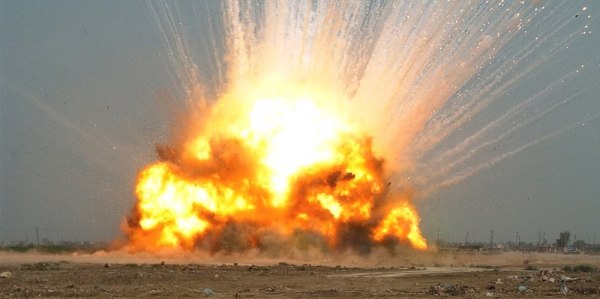

The U.S. has deployed the largest nonnuclear bomb in its inventory on an ISIS target in a remote part of far northeast Afghanistan, the Pentagon confirmed on Thursday.
The GBU-43/B Massive Ordnance Air Blast, whose acronym has inspired the nickname “Mother of All Bombs” or “MOAB,” weighs over 21,000 pounds.
It was developed during the Iraq War. It had not been used in combat until now.
It was dropped on an ISIS-Khorasan, or ISIS-K, camp in the Achin district of Afghanistan’s Nangarhar province, which borders northwest Pakistan, U.S. officials with direct knowledge of the mission told CNN.
An online simulator called HYDESim, which stands for High-Yield Detonation Effects Simulator, “maps overpressure radii generated by a ground-level detonation.””These radii are an indicator of structural damage to buildings,” the simulator says.
“These radii are an indicator of structural damage to buildings,” the simulator says.
Through the simulator, you can see how the MOAB would affect New York City, Los Angeles, London, and other big cities, based on the HYDESim’s estimate of its explosive yield. (The exact yield is classified, but it’s approximately .011KT)
Screenshot via HYDESim

Based on the simulator’s calculations, the effects of the bomb would be widely felt, causing “most glass surfaces, such as windows” to shatter, “some with enough force to cause injury” as much as a mile from the blast site, according to the simulator. The actual blast would likely destroy one or two city blocks.
By contrast, the U.S.’s most powerful nuclear bomb — the B83, with a 1.2 megaton maximum yield — would have a blast radius of nearly 20 miles.
The MOAB strike on Thursday “was designed to minimize the risk to Afghan and U.S. forces conducting clearing operations in the area while maximizing the destruction of ISIS-K fighters and facilities,” U.S. Central Command said in a statement.
“As ISIS-K’s losses have mounted, they are using IEDs, bunkers, and tunnels to thicken their defense,” Gen. John Nicholson, commander of U.S. forces in Afghanistan, said in the statement. “This is the right munition to reduce these obstacles and maintain the momentum of our offensive against ISIS-K.”
Watch footage of the MOAB being tested:
More from Business Insider:
- This 100-year-old explosion completely dwarfs the ‘mother of all bombs’ blast
- The White House won’t say whether Trump authorized use of the ‘mother of all bombs’
- Here’s why the ‘mother of all bombs’ exploded 6 feet above its target in Afghanistan
- Here’s how much the ‘mother of all bombs’ the US just dropped on ISIS in Afghanistan actually cost
- Trump says he is ‘very, very proud’ of the military’s ‘successful job’ dropping the ‘mother of all bombs’ on ISIS